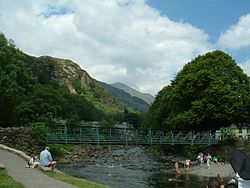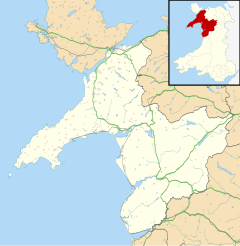Beddgelert (Welsh: [bɛðˈgɛlɛrt] ⓘ) is a village and community in the Snowdonia area of Gwynedd, Wales. The population of the community taken at the 2021 census was 460 (rounded to the nearest 10).[1] This includes Nantmor and Nant Gwynant. It is reputed to be named after the legendary hound Gelert. The community is large and sparsely populated and covers 86 square kilometres.[2]
| Beddgelert | |
|---|---|
 The village viewed from Mynydd Sygun | |
Location within Gwynedd | |
| Area | 85.93 km2 (33.18 sq mi) |
| Population | 460 (2021 census) |
| • Density | 5/km2 (13/sq mi) |
| OS grid reference | SH591482 |
| Community |
|
| Principal area | |
| Country | Wales |
| Sovereign state | United Kingdom |
| Post town | CAERNARFON |
| Postcode district | LL55 |
| Dialling code | 01766 |
| Police | North Wales |
| Fire | North Wales |
| Ambulance | Welsh |
| UK Parliament | |
| Senedd Cymru – Welsh Parliament | |




Location
editThe village stands in a valley at the confluence of the River Glaslyn and the Afon Colwyn. Just above the confluence of the rivers, in the centre of the village, is an old stone bridge with two arches. Many of the houses and hotels are built of local dark stone. To the west is Moel Hebog and to the north and a series of hills rising to the Snowdon horseshoe. The A4085 between Caernarfon (13 miles or 21 kilometres north) and Porthmadog (8 miles or 13 kilometres south) runs through the village.
The outdoor equipment company Gelert originated in Bryncir then moved to Beddgelert but later moved its headquarters to nearby Porthmadog.[3]
History
editThe folk tale of the faithful hound "Gelert" is often associated with the village. A raised mound in the village is called "Gelert's Grave" and is a significant tourist attraction. But the grave was built by the late 18th-century landlord of the Goat Hotel, David Pritchard, who created it in order to encourage tourism. Similar legends can be found in other parts of Europe and Asia.[4]
The village is probably named after an early Christian missionary and leader called Celert (or Cilert) who settled here early in the 8th century. The earliest record of the name Beddgelert appears on a document dated 1258, and the name recorded is "Bekelert". In a document of 1269 it is recorded as "Bedkelerd".[5] The current name of the village is often rendered "Begél" in the local Welsh dialect.[6]
The Church of St. Mary stands at the end of Stryd yr Eglwys (Church Street). This was originally a part of an Augustinian Monastery (the chapel), but is all that remains since the rest of the monastery was burnt down during Edward I's war of conquest.[7] Rebuilding was probably not completed at the time of the suppression of the monastery in about 1536. Parts of the building date from the 12th century and is still in active use today.
Economy and attractions
editBeddgelert is a significant tourist attraction, its picturesque bridge crossing the Afon Colwyn just upstream of its confluence with the Afon Glaslyn. It is also the nearest village to the scenic Glaslyn gorge, an area of tumultuous river running between steep wooded hills. Much of the area is, however, becoming invaded by the alien plant, Rhododendron ponticum which provides a covering of pink blossom in May and June, but which is slowly blanketing out the native flora. Attempts have been made to control its spread by cutting and burning.
River levels on the River Glaslyn in Beddgelert are constantly monitored by the Natural Resources Wales, in order to give advance warning of flood conditions lower down the valley.[8]
Beddgelert has a range of hotels with public bars, guesthouses, cafes, and restaurants. The car park in the village provides the easiest access route for climbing Moel Hebog, the mountain which directly overlooks the village.
Part of the restored Welsh Highland Railway runs through the village. In April 2009 the railway station was reopened to the public. The line links the village with Caernarfon to the north and Porthmadog to the south.
Other local attractions include the Sygun Copper Mine.
The village is also linked with the Rupert Bear stories, as Alfred Bestall wrote and illustrated some of the stories whilst he lived in the village, in a cottage at the foot of Mynydd Sygun.[9] There is even a small area known as 'Rupert Garden' in the village, dedicated to the Bear; a short walk from Alfred Bestall's old home.
Many films have made use of the scenery around Beddgelert, most notably The Inn of the Sixth Happiness, starring Ingrid Bergman. Parts of Lara Croft: Tomb Raider – The Cradle of Life, starring Angelina Jolie, were also shot here.[10]
Demographics
editIn 2021 the population of Beddgelert was recorded as 460, 34.5% of which were aged 55 to 74, higher than the national average of 25.1%. The largest ethnic group is White, making up 97.2% of the population, higher than the national average of 93.8%, with the second largest being Mixed with 2.2% of the population, higher than the national average of 1.6%. The largest religious group in Beddgelert is No religion with 46.5% of the population, which is also the national average, with the second largest being Christianity with 42.6%, lower than the national average of 43.6%.[1]
Notable locals
edit- Renowned bards who lived in the area in the 15th–16th centuries include Rhys Goch Eryri (fl.1385–1448), Dafydd Nanmor (fl.1450–1490) and Rhys Nanmor (fl.1480–1513). More recently, from the 19th to the 20th centuries, both Glasynys (Owen Wynne Jones) and Carneddog (Richard Griffith) lived in Nantmor. Currently Nantmor is still home to poets, including Nia Powell and Cynan Jones.
- John Williams (c. 1584 – c. 1627), goldsmith who worked for King James I, was from Beddgelert, and donated a silver cup to the church in 1610.[11]
- Marged ferch Ifan (1696–1793), Welsh harpist and wrestler, was born here.[12]
- Alfred Bestall (1892–1986), one of the illustrators and storytellers of the comic strip character Rupert Bear, lived in the village for many years.
Beddgelert meteorite
editOn 21 September 1949 a meteorite struck the Prince Llewelyn Hotel in the early hours of the morning, causing damage to the roof and a bedroom in the hotel. The following week the Caernarvon & Denbigh Herald reported the incident:
STRANGE HAPPENING.- About 3 a.m. on the morning of September 21st, a piece of metal weighing about 5 pounds fell through the roof of Prince Llewelyn Hotel to a bedroom below. The noise was heard throughout the village, and up to the present no explanation has been forthcoming for the mysterious happening.[13]
The proprietor of the hotel, a Mr Tillotson, subsequently sold half the meteorite to the British Museum and half to Durham University, which had placed an advertisement in the local papers asking for information and offering a reward for any recovered fragments of the meteorite.
There have only ever been two such verified meteorite falls in Wales: the Beddgelert incident, and an earlier incident 14 miles (23 kilometres) away in Pontllyfni in 1931, at the other end of the Nantlle Ridge.
References
edit- Notes
- ^ a b "Build a custom area profile - Census 2021, ONS". www.ons.gov.uk. Retrieved 20 March 2024.
- ^ UK Census (2011). "Local Area Report – Beddgelert Parish (W04000048)". Nomis. Office for National Statistics. Retrieved 26 August 2020.
- ^ "Gelert - About us". Gelert. Retrieved 7 June 2016.
- ^ "The Legend of Gelert the Dog". Historic UK. Retrieved 8 September 2019.
- ^ Nicolaisen, Gelling & Richards 1986, p. 49
- ^ Rhys, Guto (2022). Amrywiaith 2 - Blas ar dafodieithoedd Cymru (in Welsh) (1 ed.). Llanrwst: Carreg Gwalch. p. 40. ISBN 9781845278526.
- ^ "An Inventory of the Ancient Monuments in Caernarvonshire: II Central: the Cantref of Arfon and the Commote of Eifionydd". Royal Commission on the Ancient and Historical Monuments of Wales. Retrieved 8 September 2019 – via Google Books.
- ^ Natural Resources Wales - Glaslyn at Beddgelert
- ^ "Rupert Bear and Beddgelert". Beddgelerttourism.com. Retrieved 26 April 2013.
- ^ "Places in Wales known for being TV or film locations". Archived from the original on 3 November 2016. Retrieved 1 November 2016.
- ^ WILLIAMS, JOHN (fl.1584-1627?), goldsmith, Dictionary of Welsh Biography
- ^ Ceridwen Lloyd-Morgan, 'Marged ferch Ifan (bap. 1696, d. 1793)', Oxford Dictionary of National Biography, Oxford University Press, 2004 accessed 10 Oct 2015
- ^ "Meteorite falls in Wales". www.jonesbryn.plus.com. Archived from the original on 18 September 2015. Retrieved 8 September 2019.
- Bibliography
- Nicolaisen, W. F. H.; Gelling, Margaret; Richards, Melville, eds. (1986), The Names of Towns and Cities in Britain, Batsford, ISBN 978-0-7134-5235-8
External links
edit- Media related to Beddgelert at Wikimedia Commons
- Beddgelert Travel Guide Archived 14 February 2019 at the Wayback Machine
- Beddgelert Snowdonia Guide
- www.geograph.co.uk : photos of Beddgelert and surrounding area
- Map sources for Beddgelert

